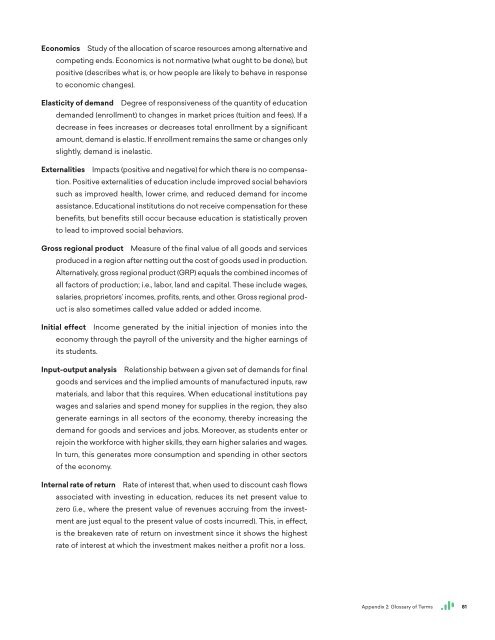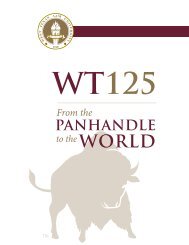The Economic Value of WTAMU Main Report
This report assesses the impact of West Texas A&M University (WTAMU) on the regional economy and the benefits generated by the university for students, taxpayers, and society. The results of this study show that WTAMU creates a positive net impact on the regional economy and generates a positive return on investment for students, taxpayers, and society.
This report assesses the impact of West Texas A&M University (WTAMU) on the regional economy and the benefits generated by the university for students, taxpayers, and society. The results of this study show that WTAMU creates a positive net impact on the regional economy and generates a positive return on investment for students, taxpayers, and society.
Create successful ePaper yourself
Turn your PDF publications into a flip-book with our unique Google optimized e-Paper software.
<strong>Economic</strong>s Study <strong>of</strong> the allocation <strong>of</strong> scarce resources among alternative and<br />
competing ends. <strong>Economic</strong>s is not normative (what ought to be done), but<br />
positive (describes what is, or how people are likely to behave in response<br />
to economic changes).<br />
Elasticity <strong>of</strong> demand Degree <strong>of</strong> responsiveness <strong>of</strong> the quantity <strong>of</strong> education<br />
demanded (enrollment) to changes in market prices (tuition and fees). If a<br />
decrease in fees increases or decreases total enrollment by a significant<br />
amount, demand is elastic. If enrollment remains the same or changes only<br />
slightly, demand is inelastic.<br />
Externalities Impacts (positive and negative) for which there is no compensation.<br />
Positive externalities <strong>of</strong> education include improved social behaviors<br />
such as improved health, lower crime, and reduced demand for income<br />
assistance. Educational institutions do not receive compensation for these<br />
benefits, but benefits still occur because education is statistically proven<br />
to lead to improved social behaviors.<br />
Gross regional product Measure <strong>of</strong> the final value <strong>of</strong> all goods and services<br />
produced in a region after netting out the cost <strong>of</strong> goods used in production.<br />
Alternatively, gross regional product (GRP) equals the combined incomes <strong>of</strong><br />
all factors <strong>of</strong> production; i.e., labor, land and capital. <strong>The</strong>se include wages,<br />
salaries, proprietors’ incomes, pr<strong>of</strong>its, rents, and other. Gross regional product<br />
is also sometimes called value added or added income.<br />
Initial effect Income generated by the initial injection <strong>of</strong> monies into the<br />
economy through the payroll <strong>of</strong> the university and the higher earnings <strong>of</strong><br />
its students.<br />
Input-output analysis Relationship between a given set <strong>of</strong> demands for final<br />
goods and services and the implied amounts <strong>of</strong> manufactured inputs, raw<br />
materials, and labor that this requires. When educational institutions pay<br />
wages and salaries and spend money for supplies in the region, they also<br />
generate earnings in all sectors <strong>of</strong> the economy, thereby increasing the<br />
demand for goods and services and jobs. Moreover, as students enter or<br />
rejoin the workforce with higher skills, they earn higher salaries and wages.<br />
In turn, this generates more consumption and spending in other sectors<br />
<strong>of</strong> the economy.<br />
Internal rate <strong>of</strong> return Rate <strong>of</strong> interest that, when used to discount cash flows<br />
associated with investing in education, reduces its net present value to<br />
zero (i.e., where the present value <strong>of</strong> revenues accruing from the investment<br />
are just equal to the present value <strong>of</strong> costs incurred). This, in effect,<br />
is the breakeven rate <strong>of</strong> return on investment since it shows the highest<br />
rate <strong>of</strong> interest at which the investment makes neither a pr<strong>of</strong>it nor a loss.<br />
Appendix 2: Glossary <strong>of</strong> Terms<br />
81





